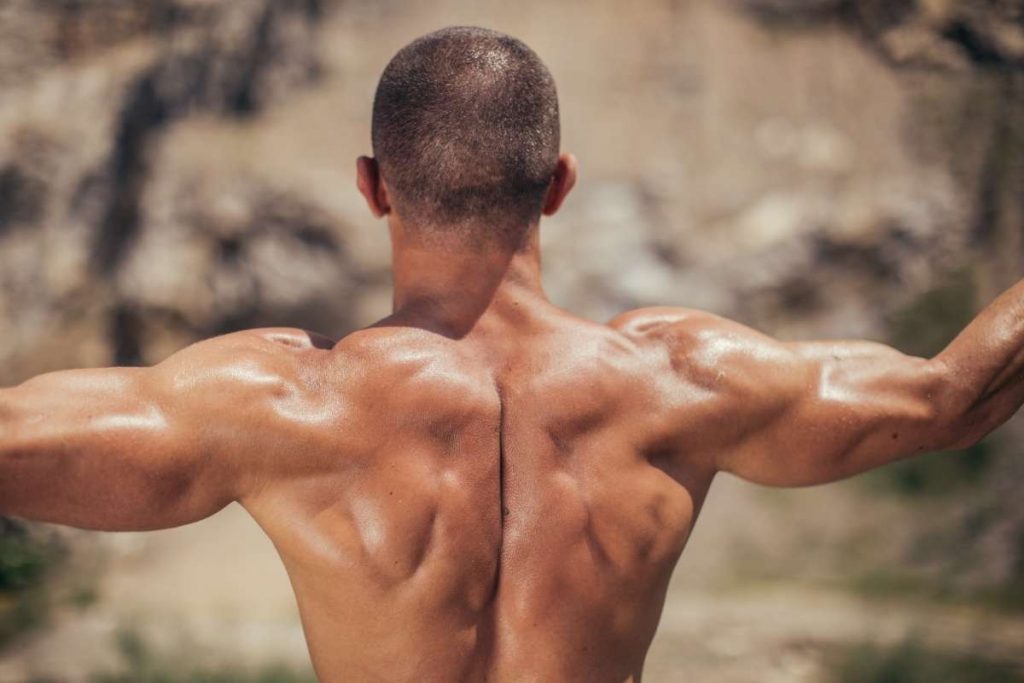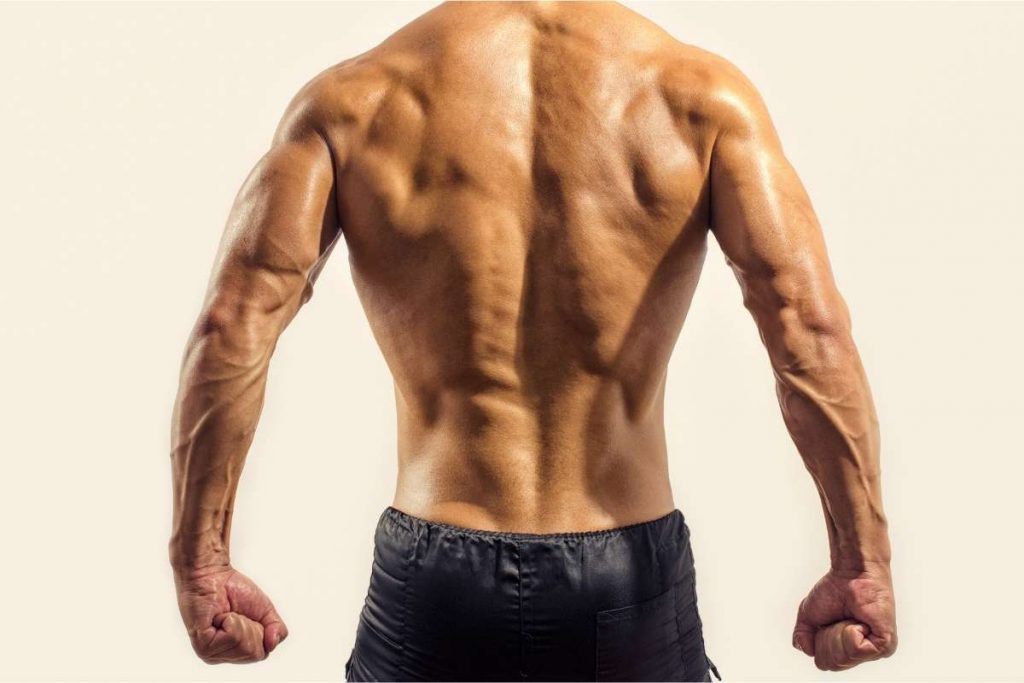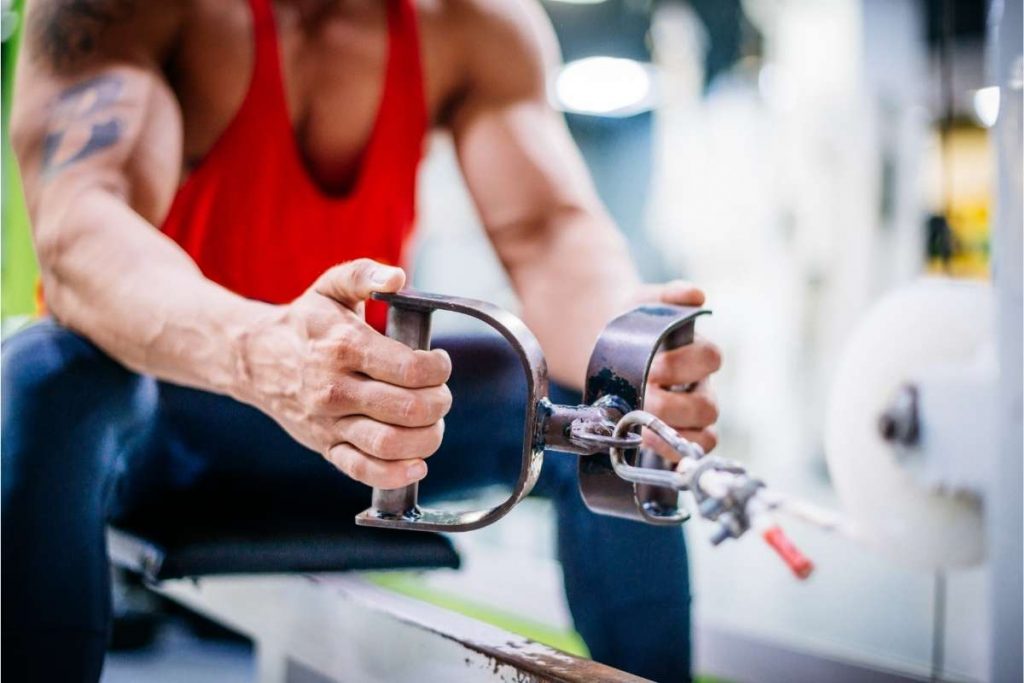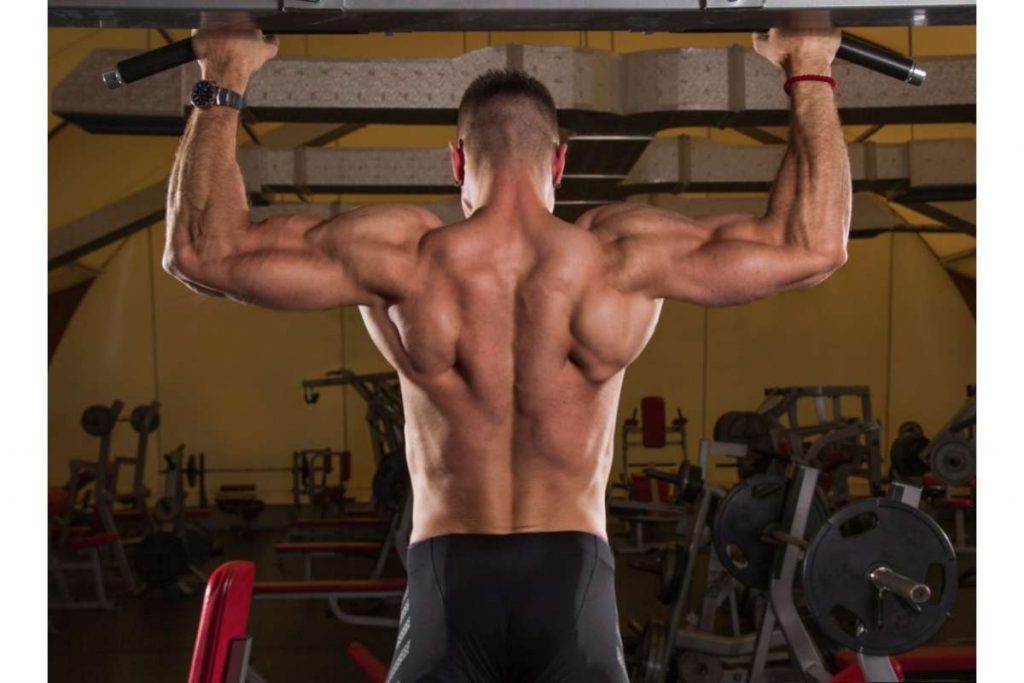What's inside
When it comes to the most popular muscle groups to train, the chest, shoulders, and arms usually take priority.
Heck, even quads and abs get plenty of love as fellow mirror muscles.
However, one of the most important muscle groups for a complete, strong physique is the back.
There’s something awe-inspiring about seeing a defined back. Especially with good posing technique on a back double-bicep or lat spread.
But how exactly do we create that impressive defined back look?
This article provides the best tips, back exercises, and workout plans to create a defined back.
What is back definition?
Related: Transform Your Back At Home

A defined back has a distinct look resulting from several factors coming together.
The first is good muscle development of all of the superficial muscles of the back. We’ll cover this in detail shortly.
The second factor is a low enough body fat percentage to avoid those pesky love handles or bat wings covering up your gains.
Body fat levels also have to be low enough to show a good amount of muscle separation.
At the extreme level, extra-shredded physiques will also show off things like muscle striations in the lower back, and accentuated veins in certain areas like the lats.
About Your Back Anatomy
The following muscle groups make up the superficial or outer layer of muscle which will portray a muscular back.
There are also many other deep back muscles that play supporting roles in trunk and spine movement.
Trapezius
The ‘traps’ are the large kite or diamond-shaped muscles reaching from the back of the neck to the shoulders and down to the mid-back.
These large muscles have several sections and perform movements such as scapular elevation and retraction.
Latissimus Dorsi
The ‘lats’ are the wide muscles that fan down from the upper arm into the thoracolumbar fascia of the low back.
The lats are prime movers in shoulder extension and adduction, playing a large role in pulling movements.
Along with the traps, the lats are one of the back muscles which can also be seen from the front. This makes them important in aesthetics-based sports such as bodybuilding.
Teres Major
A supporting muscle to the lats, the teres major stems from the shoulder blade to the upper arm, extending and internally rotating the shoulder.
The teres major is often confused with the teres minor as a rotator cuff muscle, which it is not. It has no connection to the shoulder capsule itself.
Rhomboids
While the rhomboids major and minor can’t be seen as they lie underneath the trapezius, they contribute greatly to back muscle mass and function.
The rhomboids have the primary function of pulling the shoulder blades back and up, making them key in many rowing movements for a full range of motion.
Rear Deltoid
The posterior portion of the ‘delts’ shoulder muscle is part of an overall well-defined back look.
The rear delts help horizontally extend the shoulder and sit alongside the traps when viewed from a back pose.
Rear delts can be trained during a shoulder session but are included in the training here as part of a complete defined back workout.
Erector Spinae
Finally, we have the erector spinae group of muscles. These are responsible for stabilizing and extending the lumbar spine.
They’re not only critical in protecting the back from injury, but they’re also an essential part of a defined back.
Some of the most impressive defined backs are due to well-built, lean erector spinae muscles.
What are the benefits of training the back?
Complete Aesthetics
For an overall well-built physique, training the back is essential for the look of the body from the front, sides, and of course, from the back.
In competitive bodybuilding, a muscular back is key in many of the most used poses.
The traps are a feature in the most muscular pose, and the lats are critical for creating a V-taper from the shoulders to the waist.
Even the rear delts are an important feature in side poses, and physiques where they are weak are noticeable.
Of course, poses like the lat spread or rear double bicep require impressive back muscle definition and size to score well.
Increased Function
A defined back doesn’t just look good, it helps performance as well.
The back muscles are the workhorses of any pulling movement. They support the trunk and upper limb in many other exercises.
Injury Prevention
Building on the last point, back exercises help protect the lower back, neck, and shoulders from injury.
If you’re training the chest and shoulders, you need a back workout to balance out your development and posture.
Overall Goals
Whether you are focused on muscle growth, fat loss, strength, or just general health, back exercises are part of any good training program.
More muscular development from your back workout will aid with all of the goals above, so there’s no good reason to ignore back exercises in your training schedule.
How to Get a Defined Back
Related: Top 10 Middle Back Exercises

You have to work for it.
A defined back requires good muscle mass in all the major areas along with a low enough body fat to show the separation between the muscles.
In the following sections, we’ll explain some of the best back exercises for definition.
Next, you’ll find a back definition workout for both beginner and more experienced lifters.
And be sure to check out the tips for carving out a defined back, as these will cover extra techniques to add to your overall routine.
Top 10 Back Exercises to Include in Your Workout Plan
1. Seated Row
The seated row and its variations are a relatively safe and effective horizontal pulling exercise.
This type of row is a great overall back developer and a good multi-joint exercise for beginners.
Equipment Requirements: Supported row machine, seated cable row machine
How-To Perform Seated Row:
- Sit on the padded seat and grab the handle to take up the weight
- With the knees bent, shuffle back so you can place your feet on the supports one at a time
- Straighten the legs until they have just a slight bend, and sit tall with the back straight
- Starting with the arms fully extended, squeeze the glutes and brace the core as you pull the handle toward your upper abs
- Control the handle to the starting position
Benefits: Foundational horizontal strength-builder, good for all fitness levels
Pro Tips: Squeeze the shoulder blades together and hold for several seconds at the contracted position to boost connection with the retractor muscles.
2. Pull-Ups
Related: 10 Best Vertical Pull Exercise
Another essential overall back exercise for definition is the pull-up, which involves the lats, lower back, abs, arms, and many other supporting muscles.
While difficult for many beginners, this functional exercise has so many benefits that it’s worth the time and effort to master.
If you’re unable to complete full pull-ups, check out this video on several progression exercises you can use to get there.
Equipment Requirements: Pull-up bar
How-To Perform Pull-Ups:
- Grab the bar at a comfortable width, placing the palms over the top of the bar
- Hang in a dead hang position with the knees bent if necessary; avoid crossing the legs over
- Start by pulling the shoulder blades back and down with a rigid core and lower body
- Drive your chest up toward the bar, pulling the elbows down and back
- Pause at the top with the chin over the bar
- Slowly control yourself back down to a dead hang position
Benefits: Bodyweight exercise, great core strengthener, fundamental movement
Pro Tips: Experiment with different grip widths and positions to find the most comfortable one for you.
3. Archer Row
This exercise combines a single-arm rowing motion with trunk rotation, using the muscles of the back in a unique way.
This exercise can help correct weaknesses between limbs, strengthen the core, and help protect the spine.
Equipment Requirements: Cable machine, single handle
How-To Perform Archer Row:
- Stand side-on to the high cable handle
- Reach across the body to grab the handle
- Stay centered and exhale to pull the handle to the same-side shoulder
- Squeeze the elbow back and down while rotating the body to the front
- Slowly control the weight back to the start position
- Repeat on both sides for repetitions
Benefits: Works the muscles of scapular retraction while also adding a rotational core strength element
Pro Tips: Think of pulling with the elbow first rather than using the bicep to perform the movement.
4. Reverse Fly
The rear delt is not only worth developing for the look and function of the shoulders but for a defined back as well.
This exercise is one of the best at stimulating the posterior deltoid muscle and can be done as part of a shoulder or back workout.
Equipment Requirements: Fly machine, cable machine
How-To Perform Reverse Fly:
- Set the machine handles fully to the rear
- Sit with the chest against the backrest with hands at shoulder height
- Press chest into the pad while squeezing rear delts to pull arms out and back
- Contract and focus on rear shoulders, holding for a second
- Slowly control handles back together without relaxing fully
- Repeat repetitions, breathing out for contraction and in to return weight
Benefits: Completes a defined back from the traps into the back of the shoulders
Pro Tips: Although it will feel counterintuitive, try not to squeeze the shoulder blades back, instead using the rear delts to extend the arms back.
5. Back Extension
Next, it’s time to develop another important piece of a completely defined back, the erector spinae muscles.
The back extension is not only one of the best ways to target these muscles, but it also helps protect the lower back from injury by strengthening the posterior chain.
Equipment Requirements: Back extension machine
How-To Perform Back Extension:
- Lie on a hyperextension bench with the feet behind the pads
- Hold the arms across the chest
- Bend forward at the hips slowly
- Come down until you feel a good stretch on the hamstrings and low back
- Squeeze the glutes, hamstrings, and lower back to extend upward
Benefits: Strengthens and sculpts the erector spinae muscles, protects the lower back
Pro Tips: Hold a weight plate across the chest when you need more challenge in the exercise
6. T-Bar Row
The T-bar row is an excellent exercise for building mass and thickness in the upper back and lats.
Anchoring the end of the bar provides more stability for the lower back and creates an angle that targets the mid and upper traps.
Equipment Requirements: Barbell, plates, neutral grip handle, landmine attachment
How-To Perform T-Bar Row:
- Stand with the feet on either side of the barbell with the handle slid up to just behind the plate
- Lean back into your heels and lift the weight off the ground, keeping your spine straight
- Sit back slightly, keeping the torso tilted forward at the hips
- Set the shoulder blades and breathe out as you row the handle into your lower chest
- Hold at the top, then slowly control to the starting position
Benefits: More secure for lower back while still a solid compound lift for upper back
Pro Tips: Anchor the bar in a sturdy corner or between plates if you don’t have a landmine attachment.
7. Lat Pulldown
The lat pulldown is a commonly used alternative for pull-ups, with more accessibility and isolation for the lats in a vertical pull.
If you want a wide, V-shaped back, the lat pulldown is one of the best back exercises you can do.
Equipment Requirements: Lat pulldown machine
How-To Perform Lat Pulldown:
- Set the seat and knee pad so you can sit comfortably with the hips and knees bent at 90 degrees
- Grip the handle at the desired width with either an overhand or underhand grip, and sit down on the seat with the knees secured under the pad
- Lean back slightly and lift the chest high, setting the shoulder blades
- Engage the lats as you pull the bar down to your collar bones
- Squeeze the upper back hard and hold briefly before controlling back to the starting position
Benefits: Lower barrier to entry, easy to progress in small increments, good for back width
Pro Tips: Try different grips and handle types to stimulate the back muscles differently with variations.
8. One-Arm Row
The one-arm row is another exercise that can develop each side individually to keep symmetry in the back muscles.
The cable version in the advanced workout below also includes a side bend, as the lats also play a role in lateral trunk flexion.
Equipment Requirements: Dumbbell, flat bench
How-To Perform One-Arm Row:
- Place one knee onto a flat bench with the hand resting on the bench just in front of the knee
- For the no-bench version, stand with one foot forward and rest the hand on the thigh
- Hold the dumbbell in your working hand, arm hanging straight down, and brace and straighten the back
- Engage the muscles of the lower body and core and breathe out as you pull the weight up to the side ribs
- Slowly control the weight down until the arm is fully extended in the starting position
Benefits: Accessible exercise, functional single side pulling movement, overall back developer
Pro Tips: Let the weight hang and the shoulder blade stretch at the end range of the movement, without twisting the back.
9. Lat Pullover
The lat pullover is one of the best exercises to isolate the lats in a large range of motion.
It simulates an athletic movement, making it useful for swimmers, throwing athletes, and those who simply want wide, sculpted lats.
Equipment Requirements: Dumbbell, bench
How-To Perform Lat Pullover:
- Lie face-up on a weight bench, with the feet flat on the floor
- Hold a dumbbell at the chest with both hands
- Lift the weight above the chest, keeping the arms straight but not locked
- Slowly lower the arms into an overhead position, feeling a stretch in the lats
- Keep the core tight and breathe out as you extend at the shoulders to bring the weight back up to the starting position
Benefits: Isolates lats in shoulder extension, provides great stretch position under tension
Pro Tips: Only pull the weight to just above eye level to keep tension on the lats throughout the entire set.
10. Shrugs
Finally, we have another back muscle that adds to an impressive physique when viewed from any angle.
Shrugs help build the upper trapezius, creating a strong, defined look from the shoulders to the head.
Equipment Requirements: Barbell, weight plates
How-To Perform Shrugs:
- Unrack or perform a deadlift movement to get to a standing position with the bar held in front of the thighs
- Engage the glutes as you take a very slight lean forward
- Pull the tips of your shoulders toward your ears
- Hold at the top and slowly lower until the arms are hanging straight and you feel a stretch in the traps
Benefits: Develops the upper traps, as well as grip strength which can carry over to other back exercises
Pro Tips: Keep the range of motion straight up and down, avoiding any jerking, rolling, or bouncing of the weight.
The Best Defined Back Workout Program

The following workouts are designed to help lifters at different experience levels develop a strong, defined back.
The beginner program focuses on building strength in compound movements, with some isolation work for the rear shoulders and lower back.
The advanced workout adds more volume to cover and develop the lats, traps, rear delts, and lower back, with heavy mass-building exercises and moves to sculpt the smaller muscles.
In terms of a weekly schedule, these workouts can be done once or twice per week as part of various workout splits.
Beginner Workout
| Exercise | Sets x Reps | Rest |
| Machine row | 3×8-12 | 2-3 min |
| Assisted pull-up / lat pulldown | 3×8-12 | 2-3 min |
| Cable archer row | 3×8-12 each side | 30 sec |
| Reverse fly machine | 3×12-15 | 1 min |
| Back extension | 3×10-15 | 30-60 sec |
Advanced Workout
| Exercise | Sets x Reps | Advanced Technique | Rest |
| T-bar row | 3-4×6-8 | – | 2-3 min |
| Weighted pull ups / wide-grip pulldown | 3-4×6-8 | Negative reps | 2-3 min |
| Barbell shrug | 3×10-12 | Drop set (last set) | 1-2 min |
| Seated cable row | 3×8-12 | 3-5 sec iso hold each rep | 1-2 min |
| Cable one-arm row + lateral flexion | 3×8-12 each side | – | 30 sec |
| DB Lat pullover | 3×8-12 | Superset w Cable straight-arm pushdown | 1 min |
| Reverse hyperextension | 3×10-15 | – | 30-60 sec |
10 Tips for Building a Well-Defined Back

1. Hit All Areas
The back exercises above aim to develop size and definition in all of the major muscle groups of the back.
Your back won’t look completely developed if there are weak points in any of these major areas.
This could be smaller and weaker rear delts, underdeveloped traps making the neck look longer, weak lats which make the shoulders look narrower, etc.
Don’t neglect any area and improve consistently for a well-defined back.
2. Train Technique
Good technique in back exercises is not only important for defined back muscles but for spinal health and injury prevention.
Good technique includes a full range of motion, no cheating (unless being used as an advanced technique), and the next point below, a good mind-muscle connection.
3. Create a Connection
Back exercises can be particularly tricky to feel in the target muscle.
Because the body doesn’t care how you do something, it only knows that you’re trying to pull the weight from A to B.
Take the time initially to lift lighter weight, and really focus the attention on squeezing the correct muscles to do the work.
4. Warm Up the Joints
You won’t get defined back muscles if you injure yourself training.
Take the time to correctly warm up the shoulders, neck, lower back, and elbows before your back workouts.
A warm-up can consist of general cardio, some arm circles, trunk twists, and a couple of warm-up sets for your first exercise.
5. Separate Sides
Several exercises listed above are purposely chosen for being single-limb exercises.
Back workouts can create or even worsen imbalances in the back muscles, where the dominant side takes over the lift.
Training both sides evenly will ensure your back muscle definition is even on both sides.
6. Isometric Holds
Another way to build on the mind-muscle connection and further stimulate the back muscles is with isometric holds.
Static holds like this can create more stimulus for muscle growth and improve strength in any sticking points you may have during an exercise.
These iso holds are usually done during the contracted portion of a back exercise, typically done when squeezing the shoulder blades back or down.
7. Master Movement Planes
Part of creating a back workout for definition and strength is not only to focus on the muscle groups but the movement patterns.
The exercises included in the back workouts above contain movements in the sagittal, frontal, and transverse planes.
This means working the back muscles in their capacities to move the limbs forward, back, to the sides, and around the body.
8. Lower Back Love
Related: Lower Back Exercises With Dumbbells
While people who do train back like to include exercises for the traps and lats, the spinal erectors often get neglected.
Not only does this limit complete back development, but it also creates a weakness that can lead to injury down the line.
Don’t skip the lower back exercises included in the workouts to create that Christmas tree-shaped lower back admired in bodybuilding.
9. Grip and Biceps
While the focus of this article is on the back muscles, the biceps and forearm muscles play a big role in back training.
Biceps can take over certain exercises if that mind-muscle connection, as well as good technique, aren’t developed.
Grip strength can be a limiting factor in heavier pulling exercises. Add grip strength training if you find this is a consistent problem in your training.
10. Reveal the Muscles
While developing large back muscles can create an impressive look in clothes, you won’t have a truly defined back if there is too much body fat covering the muscle.
Ensure your diet, cardio, and recovery are dialed in for cutting, if necessary, to uncover the back muscles underneath.
Frequently asked question
How do you get a defined back?
Getting a defined back is a combination of training the major muscle groups to build size, definition, and muscle separation.
This is combined with obtaining a low enough body fat percentage to reveal the hard-earned muscle, to varying degrees depending on your goals.
How long to get a defined back?
This depends on your starting point. If you’re a beginner, you’ll need to take the time to add a solid foundation of muscle on the back.
This can be followed by further training to define lagging back muscles while also cutting body fat as necessary.
How do I make my back look more defined?
Follow the tips and workouts above to create a well-defined back, with strong, aesthetic muscles, and lean body fat to create a wide, V-tapered look.
Stay consistent with your training and diet. Over time, you’ll start to see more definition in your back muscles.
What is a sculpted back?
A sculpted back would refer to an impressive level of muscularity combined with leanness.
Advanced bodybuilders display huge, wide lats, high traps, round rear delts, and shredded lower backs.
A sculpted back is a truly impressive sight whether in the gym or on a bodybuilding stage.
Get back to it!
So, what do you think about our tips for building a well-defined back?
The back is often underrated when people describe their dream physique. It’s a huge piece of the puzzle when striving for aesthetics.
More importantly, a strong, toned back carries you through life. Weak backs are more prone to injury, which can cut your mobility short and cause lifelong problems.
Let us know your tips for building a defined back. And if you try the program provided here, share your experience with it in the comments.
Finally, if you have any friends who need to balance out their physique from their mirror muscles, share this article with them, too.

